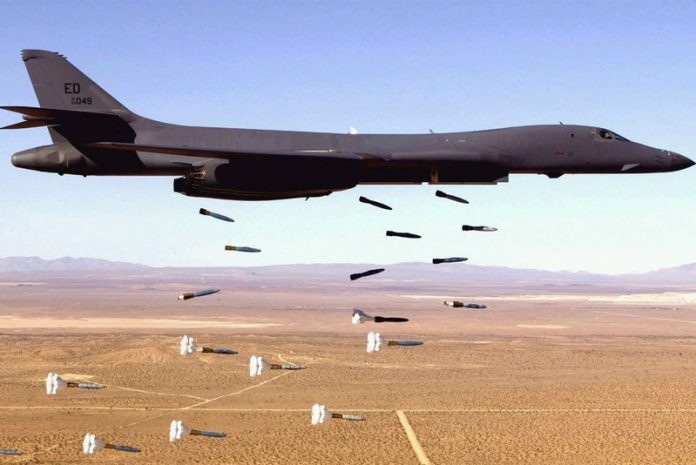
November 2019 marked the 75th anniversary of a relatively obscure, yet pivotal, engagement of the Pacific War – the Battle of Ormoc Bay.
Pacific War – the Battle of Ormoc Bay
It was a series of air-sea clashes between Imperial Japan and the Allies in November 1944 as part of the larger Battle for Leyte. Japanese attempts to send reinforcement troop convoys to the Philippine islands were interdicted by the Allies, with land-based air power playing a vital role.
From the beginning, United States Army Air Force B-25 Mitchell medium bombers inflicted heavy damage on a large Japanese troop convoy. The encounter came a year after the climactic Battle of Bismarck Sea where Allied shore-based airplanes had decimated a Japanese troop convoy.
These engagements are but two of the manifold instances of shore-based aircraft successfully attacking ships at sea during World War Two.
The German Luftwaffe FW 200 Condor during the initial stages of the Battle of the North Atlantic posed such a threat to Allied convoys that British premier Winston Churchill termed it the ‘scourge of the Atlantic’. Back to the Pacific theatre of operations, Imperial Japanese Navy medium bombers flying from Indochinese bases decimated British Force Z with the sinking of HMS Prince of Wales and HMS Repulse, marking the first occasion where capital ships were sunk by aircraft alone while underway at sea.
Anti-Surface Warfare
Land-based airpower proved its worth in the anti-surface warfare (ASuW) role during World War Two, and Pentagon thinkers today would do well to bear this in mind and let it complement US naval power to counter China’s burgeoning anti-access/area-denial (A2/AD) edifice in the western Pacific.
Terrestrial airpower could help in efforts to nullify the surface warship-component of the adversary’s A2/AD system. After all, land-based aircraft possess a number of advantages over their sea-based counterparts, especially in terms of range and payload.
US Air Force ‘Heavies’
To illustrate, the mainstay American naval strike fighter, the Boeing F/A-18E/F Super Hornet, can deploy with only a few anti-ship missiles out to several hundred kilometres.
In stark contrast, the intercontinental-ranged USAF’s Rockwell B-1B Lancer can carry up to 24 of the newly inducted Lockheed Martin AGM-158C Long Range Anti-Ship Missiles (LRASMs). With the Lancer set to remain in service into the early 2030s, the US will retain a potent long-range ASuW capability for over a decade with the B-1B/LRASM combination.
Indeed, given the increasing significance of the maritime domain, US military planners should also think long and hard the possibility of arming the upcoming Northrop Grumman B-21 Raider strategic bomber with anti-ship weapons like the LRASM.
Another shortfall that sea-based air has is that American carrier strike groups (CSGs) may not be located near a crisis spot and may take up to a few days’ steaming to reach their destination. With mid-air refuelling, USAF long-range bombers based even in the continental US can provide ‘presence’, albeit temporary, in most parts of the world within half a day.
To be certain, critics can argue that heavy bombers like the B-1B by themselves are highly vulnerable to enemy fighters, but the long striking reach of their weapons, such as the LRASM, would enable them to stay farther out within any A2/AD envelope.
Moreover, the socio-economic well-being of America’s key strategic rival, China, is highly dependent on keeping its sea lines of communications open. Indeed, the vast expanses of the Pacific Ocean and the limited number of sovereign bases in that theatre – for instance, Guam is over 2,000km away from the East and South China Seas – would mean that there will be a premium placed on the extended striking reach of Air Force ‘heavies’.
Maritime Strikes?
As much of the Joint Concept for Access and Manoeuvre in the Global Commons (JAM-GC) is classified, one may never know the true extent to which the USAF is involved in the maritime-interdiction portfolio. What is known, however, is that it has not been practising maritime strike frequently since the end of the Cold War.
This should be addressed. The neglect of dedicated training to this mission during World War Two contributed to the limitations of land-based air against shipping during that conflict. This situation could well replicate itself during a conflict involving America and China.
Given its long-range bomber capabilities, the USAF should therefore seek entrench itself more firmly in the ASuW business. The introduction of a stand-off shallow-water mine capability to its B-52 complement that was shown during Exercise Valiant Shield 2018 is a step in the right direction. Ditto the integration of the LRASM with the USAF’s B-1B bombers.
Longe-Range Bomber Exercises
What should follow naturally from these are perhaps new iterations of the Resultant Fury exercise that was held in 2004 and demonstrated the capability of USAF bombers to attack moving targets at sea with laser-guided bombs.
Future drills would do well to incorporate the LRASM and more challenging conditions so as to simulate a major-war contingency. Such are the options provided by a long-range bomber force that the noted defence analyst Robert Haddick has argued rather heretically for the US Navy to possess such a capability to better counter China’s burgeoning A2/AD edifice.
In the same vein, other commentators, echoing former US deputy defence secretary Robert Work, have called for the B-1B being transferred to the Navy as a ‘Sea Control Bomber’ that focuses on maritime strike rather than being retired in the 2030s.
Thinking Differently
All in all, with the increasing Sino-American competition in the western Pacific and the concomitant quest to re-establish maritime dominance, US military planners must dare to think differently.
In this respect, the 2018 National Defence Strategy is right on the mark when it argued for “change in the way we organise and employ forces”, as well as “developing operational concepts to sharpen our competitive advantages and enhance our lethality”.
In this regard, marrying land-based airpower with ASuW capabilities and integrating it to the counter-A2/AD game plan would be a step in the right direction.
by Ben Ho











